
Littlecote. The Street. Charmouth.
from Left to Right - Littlecote, Carrum, Beech House, Wilton House Coach and Horses and St. Andrews Church in 1870.
Littlecote stands at the corner of Lower Sea Lane and the Street in Charmouth. It would amaze most people that alongside it until it’s demolition in 1958 stood Sandford House which was equally as large. Its original boundary would have been past the white line in the centre of the road leaving an extremely narrow access, similar to that experienced today in Higher Sea Lane. With Carrum House further along, they formed a group of three Villas built between 1843-5. We are fortunate today that there are still standing a number of fine houses built at the beginning of the 19th century as a result of its attraction with Lyme Regis as a Watering Place. Jane Austen was to sum it up in her famous novel, Persusion as “Charmouth with its high grounds and extensive sweeps of country, and still more its sweet, retired bay, backed by dark cliffs, with fragments of low rock among the sands make it the happiest spot for watching the flow of the tide, for sitting in unmarried contemplation”.
Usually when I am researching the history of houses in Charmouth I have to spend a tremendous amount of time looking through every available reference to them in Wills, Poor Rates, Censuses, Directories, Parish Records, etc. This was to be the case with Littlecote and I had enough to produce this article but knew there were many gaps and questions unanswered. I was fortunate to make acquaintance with the present owner, Tom Tidy and mentioned it to him. He and his wife welcomed me to their wonderful home soon after and handed over a hessian bag with all their deeds squeezed in it. I could not believe my luck as on the outside was written Samuel Dunn, the builder and original owner which went back to when he built it in 1843. Altogether they formed an important record of both Littlecote and the plot of land that it was built on. For within them was an “Abstract of Title” which was a revelation to me as it took the history of the larger area back to 1715 when William Comings owned the building we know today as “The Coach and Horses”, but then “The Ship” and the 3 acre field on which the Tennis Courts, Community Hall, Beech House, Littlecote, Carrum, Winton House stand today. It provided the missing link to me and I was able to take the history of these buildings further back with a degree of confidence and added this information to my website: freshford.com.
If we went back in time to when Charles II made his ill-fated visit to the village in 1651, he would have seen the earlier church, with its parsonage, on the site of Beech House and an Inn owned by George Comings as its neighbour. They stood at the edge of a large 3 acre Glebe field which George rented from the Diocese on a 500 year lease. On his death in 1699 it was inherited by his son William, who in 1715 left it to his wife, Elizabeth who remarried Clement Joynes. The Ship Inn first appeared on the “Alehouse List” for Dorset in 1718, when William Kidnor is shown as its landlord. The Joynes took out a number of mortgages on the Inn until they eventually sold it with its adjoining field to Hannah Newberry from Hawkchurch in 1744. She was there for over 40 years living to a fine old age for those times. She ran the Inn initially herself and her son in law, Thomas Edwards, a Butcher, lived nearby in the former Parsonage on which was later built the property we now know as Beech House. On her death in 1787, she leaves all her properties to her two grandchildren, Hannah Dare and William Newberry Edwards. William inherits his sister’s half on her early death. He continues to live in his father’s former house where he runs a Butchers and leases the Inn which is then known as “The Three Crowns” to Joseph Bradbeer. An Insurance Policy for 1790 has survived and is very detailed showing William paying £300 for his “Household Goods, Dwelling House, Stables, Slaughterhouse, which were all thatched” and the Three Crowns leased by Joseph Bradbeer, Victualler, on “his Household Goods, Utensils, Stock and Inn which was also thatched”.
Joseph Bradbeer as well as running the Inn sets up Charmouth`s first Post Office in 1806 in what is now Nisa Store and in 1811 gives up the lease. An advert appears in the Western Times for an Auction in that year for both the Butchers and Inn which are described as:
“That well accustomed Inn or Public House, called the Coach and Horses, with the Stables, Outhouses, and Gardens thereunto belonging eligible situate in the centre of Charmouth Street, and holden under lease by Mr. Bradbeer, whose term the run will expire at Michaelmas next, and now in the occupation of Mr. Clemoes. Also, a Brick Fronted Messuage or Dwelling House, with the Outhouses and a close of exceedingly rich Meadow Land adjoining, containing about three acres more or less in the occupation of Mr. William Edwards”.
The auction could not have been successful as William Edwards continues to live in the village until 1830 when after the death of his wife, he remarries Sophia, widow of Thomas Morgan, the former landlord of The George Inn and sells his properties and moves from the village. The Coach and Horses was bought by Bowden, Gundry, of Bridport whose original Brewery stood in Gundry Lane in Bridport. The former Butchers and its 3 acre field were purchased by Isaac Cooke. He was a successful Lawyer living in Clifton, who had been Mayor of Bristol and was also Patron of Charmouth Church from 1826 until 1839 during the occupancy of William Glover and John Dixon Hales as Rectors. He bought Beech House and the field from William Newberry Edwards on the residue of a 500 year lease for £1100 and may well have rebuilt it at the same time as the Rectory as they are very similar as shown by the doorways illustrated here. The 1831 Poor rates show Isaac Cooke living and owning Beech House, with the Curate, Thomas Snow living in the new Rectory and renting a field from him, which was the piece of ground Sandford House, Littlecote and Carrum House were later to be built on. The Indenture for the sale describes it as:
"All that brick fronted messuage, tenement or dwelling house, wash house, slaughter house, offices and other outbuildings thereto belonging with the Shrubbery and ground in front of the Street of Charmouth and also that Garden and piece or close of meadow or pasture land adjoining the same said messuage, tenement or dwelling house, buildings and garden formerly called the Church Yard Close, containing by estimation three acres (be the same more or less)".
A Plan shown here is bound into the document and clearly shows William Newberry Edwards former House with the Slaughter House close by and a Shrubbery along the frontage to The Street where the 3 Villas were to be later built.
It is Littlecote`s extensive deeds that now provide the next chapter in its history, for they show that on the death of Issac Cooke, his two sons inherited his estate in 1843 and sold William Edwards former House (now Beech House) to a Miss Frances Kennaway, daughter of Sir John Kennaway for £500 and a strip of land facing the Street to William Hoare for £210, where Sandford, Littlecote and Carrum were later to be built. William Hoare would have been 33 years of age at that time, married to Eliza, daughter of Samuel Dunn, who he worked for as a Carpenter. He was to divide the strip into three and keep the end plot for Sandford Cottage and sell the middle plot to Samuel Dunn, his father in law soon after for £95. The third plot was bought by John Hodges, a Butcher, who was to later buy Beech House from Frances Kennaway. John Hodges had formerly rented a number of Glebe fields on either side of Lower Sea Lane and lived in a farmhouse where the old School stands today. But his life was to change in 1843 when he bought the plot of ground from William Hoare and had Samuel Dunn build a house on it which he called “Clarence House (now Carrum House). He went on to buy Beech House from Miss Kennaway and built “Winton House” soon after adjoining it where the former Slaughterhouse stood. At the time of his death in 1874, John Hodges owned Sandford House, Beech House and Winton House which he left to his children.
The deeds contain an Indenture of the house that was to be built with plans of the site and a sketch of how it would look which are shown here. William Hoare, as a Carpenter no doubt assisted his father in law, Samuel Dunn in the construction of his house and the other two. The Dorset Archives in Dorchester have the original Day Books for 1834 -1837 in which Samuel recorded the various jobs that he did for villagers. At the back of it is the original lease shown here to Miss Elizabeth Henning where she agrees to pay him £25 a year for the house, he had just built in 1844. Samuel then took a mortgage out for £150 on the property in the same year, which he later increased to £300, which he borrowed at 5% interest from John Attwood of Hylands Park in Essex.
Miss Elizabeth Hennings must have enjoyed her new house as she was to later buy the freehold from Samuel Dunn. Samuel Dunn was born in Sherborne and when he moved to Charmouth lived and had workshops where Peria is now, which he rented from Robert Knight. His workmen were many, amongst them were Andrew, Phillip, his brothers and his father, also William Hoare and Wheaton. Dunn afterwards went to live in the Axminster Road and his workshop was owned by John Attwood. He is remembered today as being “Clerk of the Works” when the church was being built in 1836. Sadly, he appears to have overextended his resources and went bankrupt in 1848 and he died not long after in 1852 aged 60 in Dorchester. There is beautifully carved memorial to William Hoare at the front of the grave yard at St. Andrews that reads:
In memoriam ELIZA loving wife of/WILLIAM HOARE, and only child of SAMUEL and CHARLOTTE DUNN, late of this Parish, who died November 28 h 1883, aged 69 years. “Not lost but gone before “And in/loving remembrance of WILLIAM HOARE who departed this life April 30 th 1881 aged 78 years.
The next owner of Littlecote. Elizabeth Hennings was from a distinguished family; whose lineage appears in Burkes Peerage. Her parents, Robert and Jane Hennings had six sons and six daughters and lived at Woodsford Castle, near Dorchester, She first appears in the 1841 Census as living at Stow House near the George Inn. The next Census in 1851, provides more information about her. By then she was aged 64 residing at “Littlecote” with her servant, Elizabeth Dimond, aged 30. She was to die in 1854 and be buried at St. Andrews, where her fine Tomb and Gravestone can still be seen today. In her Will she appoints her brother, John Henning and Brother in Law, Charles Castleman, Esq. and gives to her niece, Sophia Nares Henning, daughter of her late brother, Charles Masterman Henning Esq. her house. Her servant, Elizabeth Dimond is well rewarded with £200 and a further £200 to be shared with her sister, Ann and brother John as well as all the articles in her servants’ room in the house.
The next occupant of Littlecote was to be Sophia, niece of Elizabeth, whose parents were Charles and Susannah Henning, who was bought up at Alton House in Hampshire with her brother, Edward. There is a magnificent marble memorial to her mother in Wells Cathedral that reads: “
“Sacred to the memory of Suzannah Lucretia, wife of Charles Masterman Henning, of this parish, esq. second daughter of the late Hon. Sir George Nares, one of his majesty’s Judges of the Court of Common Pleas. She departed this life December 25th1818, aged 55, leaving one son and one daughter”.
With the early death of her mother, she was to look after her father, living with him in a fine house at 22 Queens Square in Bath, until his death in 1852, aged 83.
Sophia was to live over 30 years at Littlecote with her servants, but there is little to find on her life there apart from a report in the Bridport News of 1880 regarding her companion which reads as follows:
CHARMOUTH. Death of Miss Chard —We regret to record the death Miss Chard, which took place after few days illness at the residence of Miss Henning on Sunday morning last. The deceased lady resided with Miss Henning for a great many years and was very much respected both by rich and poor.
Sophia died on 8 January 1886 in Charmouth, having lived a long life of 83 years and was buried in her Aunts Grave at St. Andrews, where her gravestone can still be seen today. In her Will she left her Estate to her relations: George Caleb Hedgeland and his wife Annie Shrapnel Sloman and also Thomas Martin Sloman and Amelia Sloman his wife. All of whom were living in Sydney, Australia at the time. They were to sell Littlecote soon after to Francis George Edwards of Colyton, who paid £405 for it. He had previously rented Littlecote and was successful in the Auction of the 2nd June 1886 in buying the freehold. There are no entries for Francis Edwards as living in Charmouth and would assume that he rented the property for the 14 years of ownership. An 1895 Poor Rates List for the village has him as the owner of Littlecote and Edward Vince as his tenant. Edward ran the Grocers opposite, which we know today as Nisa, from 1888 until 1896. A marvellous photograph shown here has come down to us of him with his family in front of the house in 1895. The Title Deeds reveal that in 1900,Frances Edwards sold the house to Miss Lilian Gilchrist Thompson, wife of Rev. Henry Percy Thompson of Kippington Vicarage, Sevenoaks, Kent for £405. Again, there are no records of her living in the village and no doubt had it as an investment and continued to reside in Sevenoaks. Finally, in October 1914 we have an owner residing in Charmouth when Percy Roger Middlecott Davies pays £400 for it. He appears regularly in the Jury List for the village and in 1913, his address is given as “Sabina”, which may have been the houses former name. In June 1922 he moves from the village and sells the house to Rosalind Roberta and Edith Blanche Pargiter who pay £850, over twice the previous price. They were the daughters of The Reverend Robert Pargiter, who had until his death in 1915, aged 98, lived at Beech House, nearby. Sadly, Rosalind was to die in 1927 and her sister, Edith continued to live in Littlecote until her death in 1938, aged 72. The house was put up for Auction and The Western Gazette for July 1st report it as:
A CHARMOUTH RESIDENCE.
Acting for trustees of the late Miss E. B. Pargiter. Messrs W. Palmer & Co. and R. & C. Snell, of Axminster, sold by auction, at the premises on Wednesday, the small freehold residence and ground, known as " Littlecote," Charmouth. Mr. G.H. Parkins, of Charmouth, was the buyer at £1,020. Subsequently the auctioneers dispersed the contents of the residence, comprising some 300 lots, in good time at satisfactory prices. Messrs. Wm. Forward & Sons, of Axminster, are the solicitors.
George Hellier Parkins, who lived in Lower Sea Lane, must have been the agent as the Title deeds show it being sold to Mrs Olive Agnes Farrant, wife of Samuel Robert Farrant whom she had married in the same year. She was the daughter of Tom Havis, who had been Game Keeper for the Pass family, living at Champerhay in Wootton Fitzpaine. We are fortunate that soon after they bought the house, a register for the village the following year provides us with a snapshot of families living there. In the case of Littlecote, I was able to talk direct to one of those listed in the house at that time. For Leslie Keith Wiscombe, now 86 living in Lyme Regis is shown aged just 4 at the address. His mother was Ada Webster, whose father was Tom Havis and had divorced and remarried. Her brothers Harry and Cecil Havis were also living there with their mother, Agnes, who had separated from her husband, Tom by then. He was able to tell me that his mother Ada, Samuel Farrant and Cecil Havis all worked for Billy Gear in his garage. The house must have been very crowded, and I was surprised when he added that they also took in some of the American service men who were based in Charmouth during the war. Going through the Electoral Register for the village showed that Samuel Farrant was in the services during the war but seems to not have returned afterwards. Olive was to reside there with her brothers until 1993. With the death of Cecil in that year, she moved from the village and lived to be over 94 when she died in 2002.
Keith Lander who lived in the village bought the house in 2003 and restored and extended the house. He in turn sold it to Tom Tidy and his wife in 2015, who have continued improvements to the property which is now one of the finest properties in the village, containing many of its original period features.
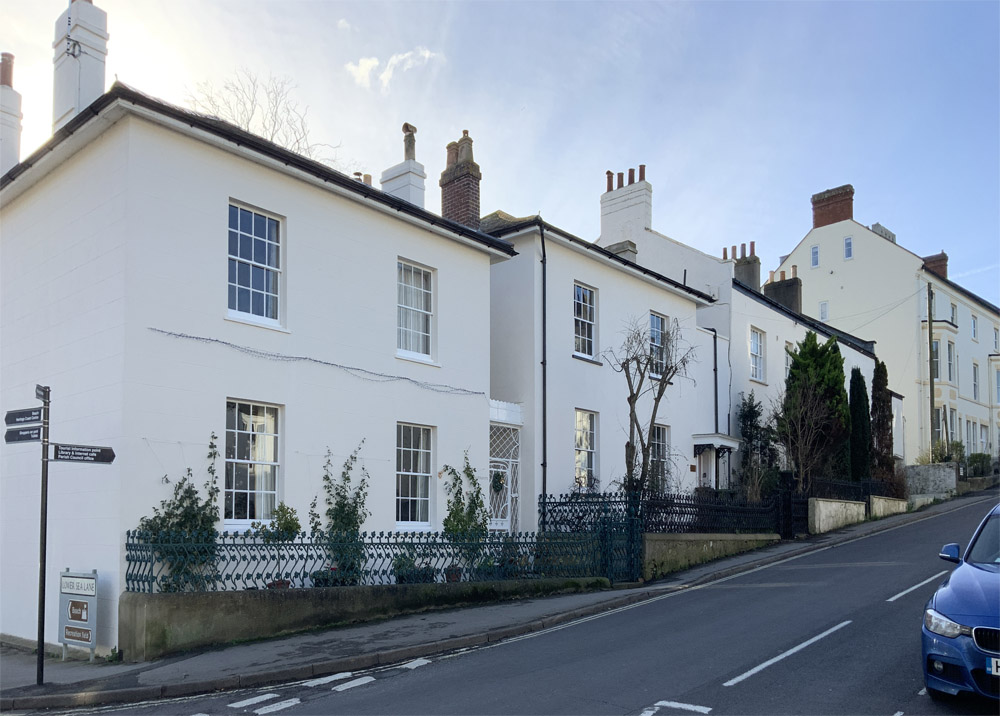
The same view today with rebuilt Coach and Horses.
from Left to Right - Sandford, Littlecote, Carrum, Beech House, Wilton House Coach and Horses in 1870.
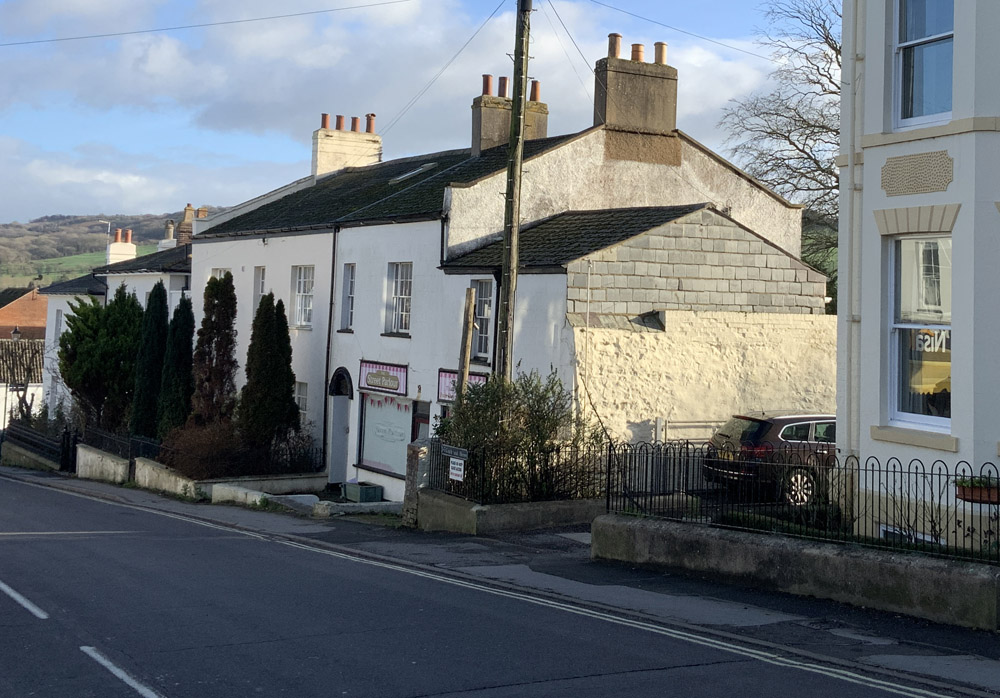
The same view today with rebulit Coach and Horses.

LIttlecote, Carrum and Beech House today.Te extension to Carrum can clearly be seen, when it was owned with Beech House by John Hodges who linked the two houses. .

Single villa, c 1830. Stone walls, stuccoed. Low pyramidal slate roof. Rendered brick stacks at projecting eaves. Two to each side. 2 storeys. 2 windows, sashes with twin glazing bars. Front door at right hand in porch adjoining Carram, wood with 4 panels. Original wooden trelliswork entrance to porch. Elliptical-headed trellis door with lozengy pattern throughout. Square cast iron gate piers to street with running scroll pattern and pineapple finials.
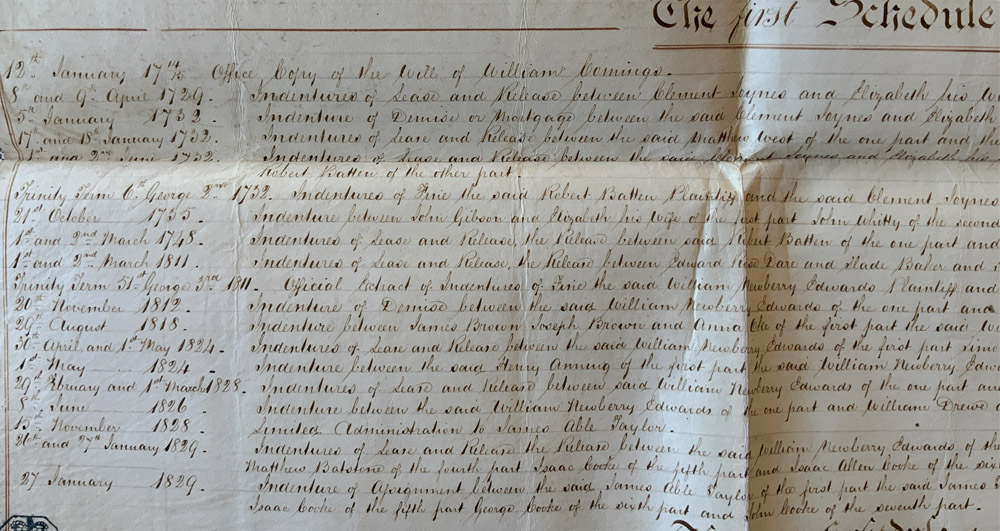
An abstract from the Schedule of Deeds which takes the histiory of the plot of ground on whichj the house stands back to 1714.
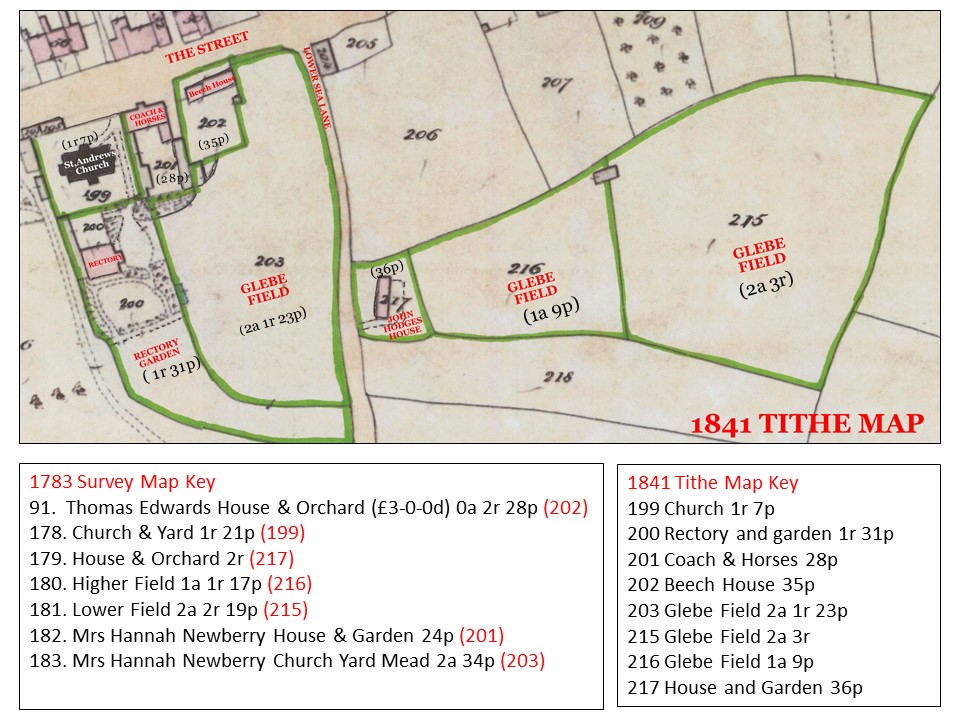
.jpg)
Maps of the site from 1839 to date.
.jpg)
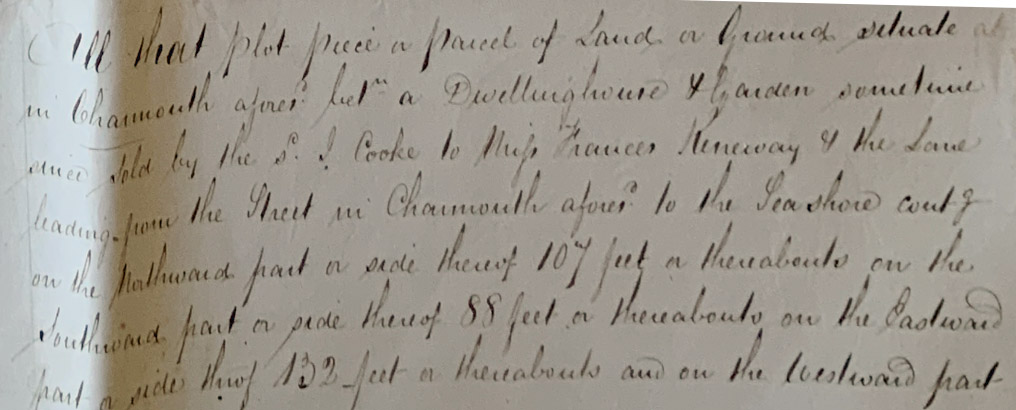
.jpg)

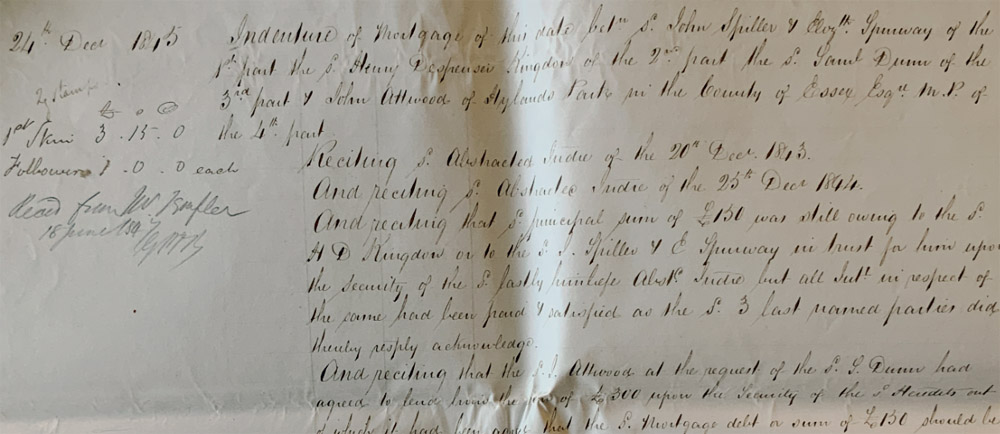
.jpg)
.jpg)
.jpg)

A photograph of the attractive rear of Littlecote taken in 2015 from the Sales brochure, when the property was put up for sale.

The building and letting "Littlecote" in 1844 by Samuel Dunn to Miss Henning for £25 a year. Mr. Bidwell`s House was The Lilacs, now Charmouth Lodge. Elizabeth Henning must have bought the House off of Samuel Dunn in 1845.
"
Memorandum made the.. day of ..1844 between Samuel Dunn, Builder and Miss Henning, both of Charmouth in the County of Dorset. Samuel Dunn doth herby .. and let unto the said Miss Henning a now building with garden and a pump of water situate in Charmouth opposite Mr. Bidwell`s for the term of one year certain for the rent of £25 per year. The House to be finished by Michaelmas day September the 29 th 1844 and also the rent to commence from the same 29th day of September, and the rent to be paid yearly, and the said Miss Henning doth agree to take the said House of Samuel Dunn for one year certain and at the rent afore mentioned and she will at her own cost and charges make good or cause to be made good and put unto the same good condition and order as when entered upon."
Samuel Dunn was born in Sherborne and when he moved to Charmouth lived and had workshops where Peria is now, which he rented from Robert Knight. The Record Office at Dorchester has his Day Book, which records the people living in the village at the time and jobs he was doing for them. It is very descriptive. He built the cholera house in 1834 which cost £24.
Mr. Burnard, well known in the village in the 1830s and a great supporter of the chapel, apparently had an unpleasant smell in his house and on November 1st. 1834 Dunn had to take down cosings, whatever that was, and found a dead rat. His charge was 1/4 and 6d for nails and tacks. He did a great deal of work at Catherston for Mr. and Mrs. Rose, throwing Timber. He repainted the chapel in May of that year, and spent many hours in the church which was beginning to show signs, of decay. He was also an undertaker. His wife was Charlotte Jefford of Uplyme and they had a, daughter - Eliza - who married his carpenter William Hoare. His workmen were many, amongst them were Andrew, Phillip, his brothers and his father, also William Hoare and Wheaton. Hoare was a clever carpenter and made the model of the old church. He lived, if he did not build it, in “Portland Cottage”. Dunn afterwards went to live in the Axminster Road and his workshop was owned by John Alwood. His chief work was being clerk of the works when the church was being built. Sadly, he appears to over extended his resources and went bankrupt in 1848. He was to die not long after in 1852 aged 60 in Dorchester.


Insolvents,
Samuel Dunn, of Charmouth, supported by Mr. Smark, and opposed by Mr. Andrew Tucker, obtained his interim order on the understanding that he is to file an account of the proceeds of a sale of a house to Miss Biffin, and an auctioneers account of the sale of his furniture under an execution in December last.
15 July 1848 - Western Times - Exeter,


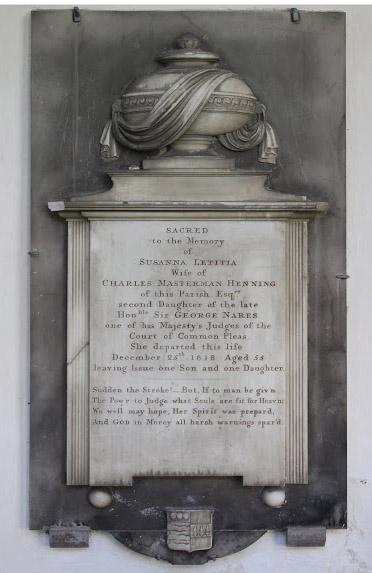
Sacred to the memory of Suzannah Lucretia, wife of Charles Masterman Henning, of this parish, esq. second daughter of the late Hon. Sir George Nares, one of his majesty’s Judges of the Court of Common Pleas. She departed this life December 25th1818, aged 55, leaving one son and one daughter.This Memorial to Sophia Hennings parents can be seen in Wells Cathedral
.jpg)
The family seat of the Hennings was Woodsford Castle, near Dorchester. shown above in this beautiful engraving.
.jpg)
shows Eliza Henning, aged 64, A Fund Holder with Elizabeth Diment, aged 30, a House Servant, which would have been Littlecote.
A House Uninhabited.
Louisa Griffith Unmarried , aged 55, Born in Gittisham, Devon and Mary Lane, Srvant, aged 55 from Warwick.
William Greenslade, Clergyman, Born in Guernsey.
John Hodges, Butcher.
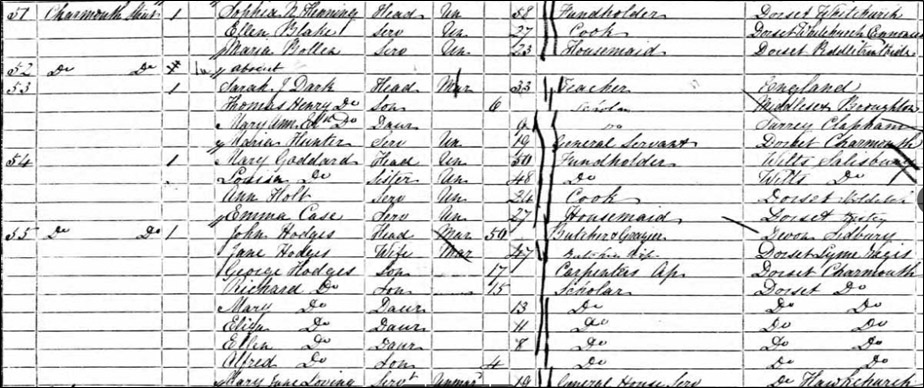
shows Martha Sophia Henning aged 58 born in Whitchurch, Dorset is living in Littlecote
Unoccupied House
Sarah Duck aged 33 a Teacher
Mary Goddard aged 50 Fundholder, Louisa Goddard, Sister, aged 48, Fundholder, both born in Salisbury.
John Hodges aged 50 Butcher
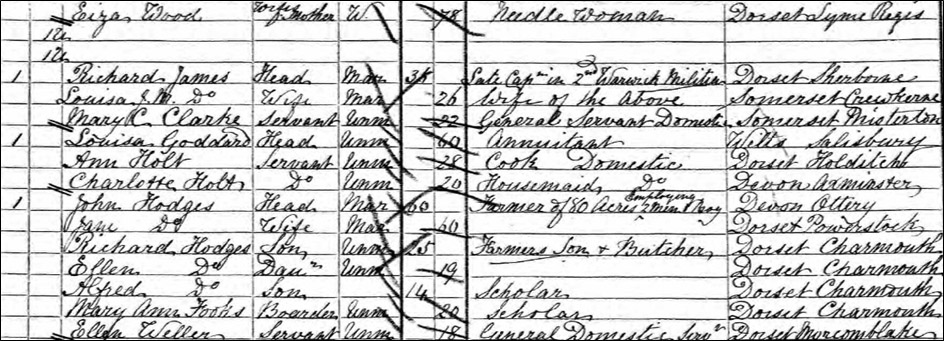
shows 2 Unoccupied House
Richard James aged 35 Late Captain in Militia
Louisa Goddard aged 60 Annuitant
John Hodges aged 60 Butcher


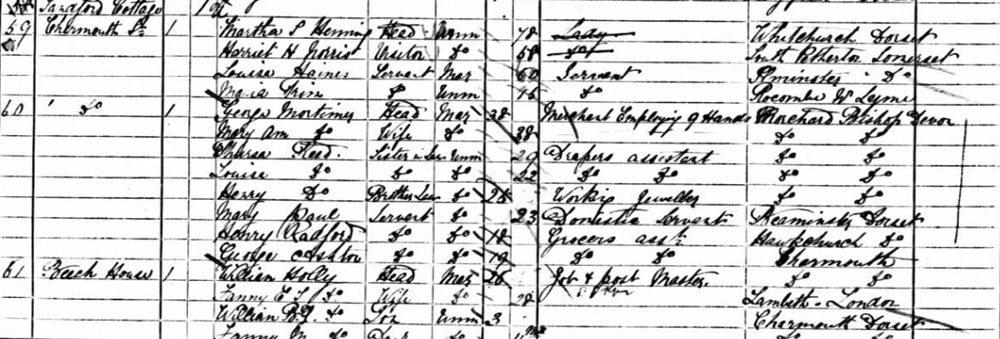
Sandford Cottage - Unoccupied
LIttlecote: Martha P.Henning.Unmarried, aged 78, Lady, born in Whitchurch. Harriet Norris, Visitor, unmarried, aged 68, Lady, born in South Petherton. Louisa Haines, married, aged 50,Servant born in Ilminster. Maria Trin? Unmarried, aged 16, Servant, Rocombe, near Lyme.
Clarence House (Carrum): shows George Mortimer (aged 38) originating from Morchard Bishop in Devon as a Merchant employing 9 hands. He is married to Mary Ann (aged 38) from the same village. His wifes sisters, Shura and Louisa Reed are Drapers Asssistants and her brother, Henry is a Working Jeweller. He employs Henry Radford and George Ashton as Grocers Assistants.
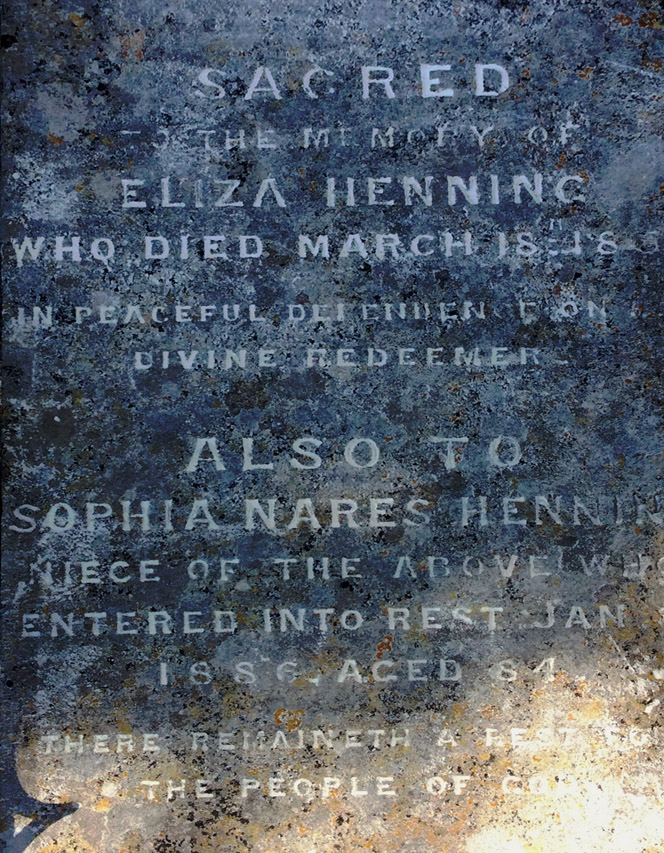

Also to SOPHIA NARES HENNING niece of the above who entered into rest Jan 8 th 1886 aged 84 "There remaineth a rest of the people of God

An Abstract from the 1895 Poor Rates showing ownership and occupiers of properties in order with their rentable values below. It would seem that Edward Archer Vince who ran Charmouth Stores oin the opposite side of The Street was renting it from John Edwards.
Sandford - Unoccupied - Frank Radford - House and Garden - Charmouth Street - £25
Littlecote - Edward Archer Vince - John Edwards - House and Garden - Charmouth Street - £25
Carrum - Harriett Goddard - George Mortimer - House and Garden - Charmouth Street - £25
Beech House - Eliza Wild - Richard Hodges - House and Garden - Charmouth Street - £25
Winton House - Alfred Stanton - Richard Hodges - House Shop and Yard - Charmouth Street - £17
Coach and Horses - Alexander Cox Pagan - Executors of Job Legg - House and Yard - Coach & Horses - £50
Littlecote - Edward Archer Vince - John Edwards - House and Garden - Charmouth Street - £25
Carrum - Harriett Goddard - George Mortimer - House and Garden - Charmouth Street - £25
Beech House - Eliza Wild - Richard Hodges - House and Garden - Charmouth Street - £25
Winton House - Alfred Stanton - Richard Hodges - House Shop and Yard - Charmouth Street - £17
Coach and Horses - Alexander Cox Pagan - Executors of Job Legg - House and Yard - Coach & Horses - £50
A similar photograph of Edward Vince`s son and friends in front of the house in 1895.
.jpg)
.jpg)



Edith Blanche Pargiter died in 1938 and her house was put up for Auction by the Trustees.

Acting for trustees of the late Miss E. B. Pargiter. Messrs W. Palmer & Co. and R. & C. Snell, of Axminster, sold by auction, at the premises on Wednesday, the small freehold residence and ground, known as " Littlecote," Charmouth. Mr. G.H. Parkins, of Charmouth, was the buyer at £1,020. Subsequently the auctioneers dispersed the contents of the residence, comprising some 300 lots, in good time at satisfactory prices. Messrs. Wm. Forward & Sons, of Axminster, were the solictors.
01 July 1938 - Western Gazette - Yeovil, Somerset, England

| Sandford Lodge | 134 | Little | William | 26th Feb. | 1875 | Colonel Indian Army Retired |
| Little | Margery | 30th Dec | 1887 | Unpaid Domestic | ||
| Church | Ann | 12th Aug | 1904 | Unpaid Domestic | ||
| Partington | Agnes | 28th Sept | 1918 | Cook Domestic | ||
| Littlecote | 135 | Favant | Samuel | 12th Feb | 1909 | Motor Driver Mechanic |
| Favant | Olive | 29th July | 1908 | Unpaid Domestic | ||
| Havis | Agnes | 30th Aug | 1873 | Unpaid Domestic | ||
| Havis | Harry | 17th Apr | 1902 | Unpaid Domestic | ||
| Havis | Cecil | 25th Mar | 1912 | General Labourer | ||
| Webster | Ada | 26th Mar | 1913 | Motor Mechanic | ||
| Wiscombe | Leslie | 4th Oct | 1935 | Under School Age | ||
| Cheney | Fred | 5th Nov | 1915 | Bread Baker Journeyman | ||
| Clarence Villa | 136 | Hunt | Marian | 22nd July | 1882 | Unpaid Domestic |
| Beech House | Mabson | William | 1st Apr | 1867 | Captain 4th Battalian | |
| Mabson | Agnes | 27th Mar | 1893 | Unpaid Domestic | ||
| Mabson | Veronica | 9th May | 1912 | Unpaid Domestic | ||
| Revell | Agnes | 17th June | 1856 | Unpaid Domestic | ||
| Baker | Margaret | 27th Nov | 1909 | Unpaid Domestic | ||
| Stroud | Beatrice | 10th Mar | 1910 | Domestic Servant |
.jpg)
Back Row-Jerrard, Matthews, Holman, White. Middle Row-Cecil Havis ( who lived at Littlecote) ,Spurdle,Loosemore, Rendle. Front Row-Aldworth, Marston, Herbert.
The "Charmouth unit was formed by Colonel William Little who lived in the Sandford, the house on the comer of The Street and Lower Sea Lane, as Commanding Officer. The platoon consisted of World War 1 veterans, youngsters awaiting call up and men in reserved occupations. I joined in August 1940. About 20 - 24 men were involved.I recall that initially we just had armbands with L.D.V. on them. .It was not long before we had battledress uniforms and some American 0.300 rifles".
An extract of an article by John Thomas in Shoreline Winter. 2019:
"My father’s elder sister, Doris, was born and raised in Lawrenny, Pembrokeshire, as he was, and also lived in the village. Dad’s first job was footman at Catherston Manor, at that time owned by Col. Bullen. Doris was cook housekeeper to Col. & Mrs. Campbell Little, who lived in Sandford Cottage, now demolished, on the corner of Lower Sea Lane. Mrs. Little died in 1947 and Doris continued looking after the Colonel until his death in the early 1960s.His identical twin brother, Matthew, lived in Vancouver and whenever he visited Charmouth, he and the Colonel attended morning service at Church wearing top hats and frock coats. After Col. Little’s death at the age of 91, Doris moved to Beech House lodging with the Mabsons and worked for Bishop Williams at 2 Hillside. Doris died in 1989, aged 87. The Union Flag covered her coffin in recognition of her work with the Royal British Legion Pop".

Charmouth Fire Brigade in the 1950s.
Back Row:Cecil Stork, Dennis Gerrard, Ernest Hutchings, Cecil Havis, Bert Smith
Back Row:Cecil Stork, Dennis Gerrard, Ernest Hutchings, Cecil Havis, Bert Smith
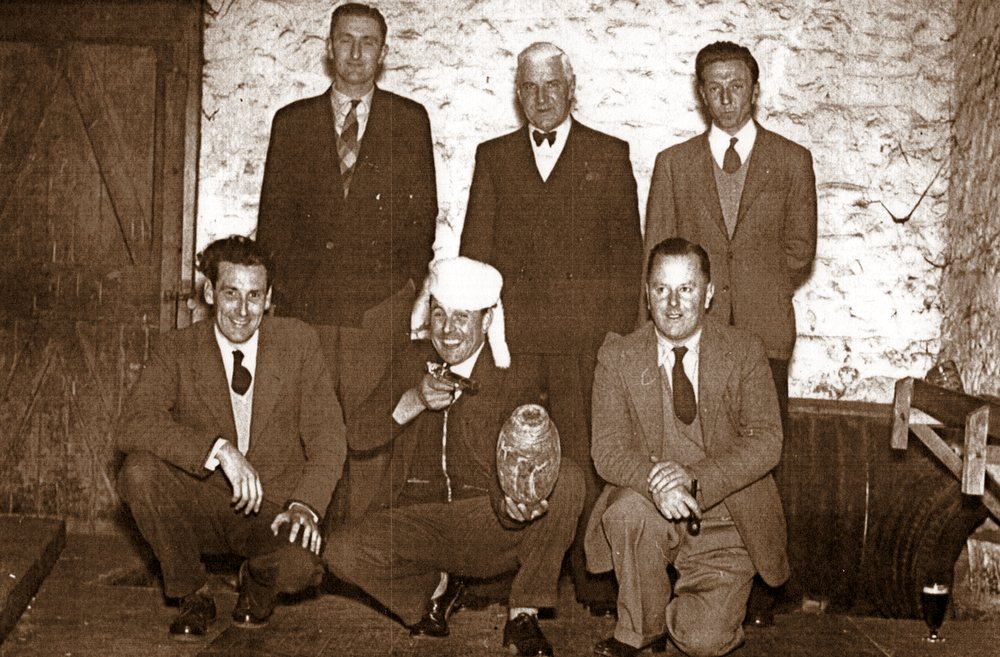

An aerial view of Littlecote soon after Sandford Cottage had been demolished in 1958.

A view of the garden and Tennis Courts which formed part of original Church Glebe.

An aerial view of Littlecote after Sandford Cottage had been demolished.